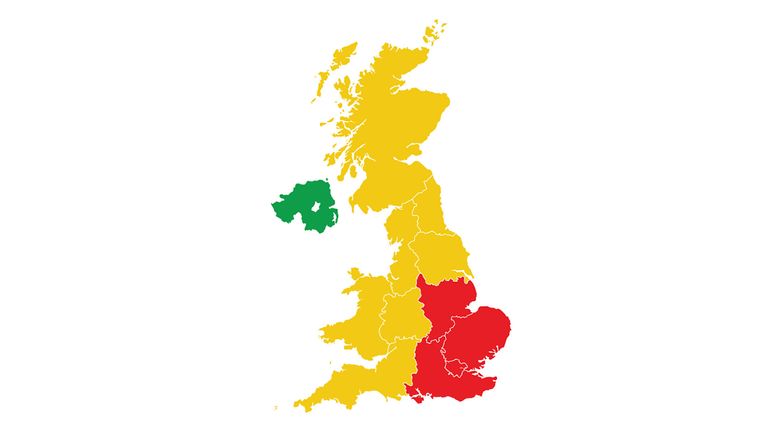Stark regional differences in fuel supply across the country have been laid bare in a government assessment revealed to Sky News.
In the most recent map, compiled today, a traffic light system used in the review shows the South East as red, which means that fuel stock levels at filling stations are under 20%.
Most of the UK has been marked as amber, meaning that stations are between 20% and 40%.
Image: A map shows fuel shortages by region, with the snapshot on the left taken on 25 to 26 September, and the one on the right taken on 1 October. Source: UK government assessmentNorthern Ireland is green, with at least 40% of supplies – which is the average stock level in normal times.
It compares with a snapshot taken on 25 to 26 September, which shows almost all of the UK running at less than 20% stock levels, except Northern Ireland.
AdvertisementIt comes as an independent fuel retailers’ group warned more than a quarter of its member filling stations are still empty and less than half have both petrol and diesel in stock.
The Petrol Retailers Association (PRA) said independent stations, which total 65% of the entire network, “are not receiving enough deliveries of fuel”.
More on Supply Crisis Related Topics: supply crisis“Whilst the situation is similar to recent days, there are signs that it is improving, but far too slowly,” said PRA executive director Gordon Balmer. “Until independents start getting frequent supplies, we will continue to see long queues at forecourts.”
Image: A worker directs cars into the forecourt as vehicles queue at a petrol station in LondonIn the latest PRA member survey of 1,100 sites across the UK, including motorway service areas, 47% reported having both petrol and diesel in stock, 27% have either one grade in stock, and 26% are empty.
The warning comes after policing minister Kit Malthouse said on Friday the situation is “stabilising”, but added if the crisis does not ease in the coming days, Boris Johnson stands ready to review the problem, which has been caused by a shortage of fuel tanker drivers.
His comments contrast with those made by other government ministers this week, including the chief secretary to the Treasury, Simon Clarke, who just yesterday claimed the situation was “back under control”.
Fuel crisis ‘is back under control’ says govtMr Malthouse said there are “pockets” of the country where there are still problems – with London and the South East reported to be among the hardest hit.
“We are still seeing strong demand in parts of the country around fuel. The distribution mechanism is trying to respond to this unprecedented demand,” he told BBC Radio 4’s Today programme.
“My latest briefing is that the situation is stabilising, that we are seeing more forecourts with a greater supply of fuel and hopefully that, as demand and supply come better into balance over the next few days, week or so, that we will see a return to normality.
Man with ‘knife’ confronts queue-jumper“I think if things started to deteriorate further, obviously the prime minister and the secretary of state for energy, whose responsibility this is, will have to review the situation.”
The PRA had warned filling stations were still running out of fuel quicker than forecourts could be resupplied, and urged motorists to return to their normal buying habits.
Mr Balmer also said forecourt staff were being subjected to a “high level” of physical and verbal abuse from frustrated drivers.
Woman fills water bottles with petrol“What we need to see is a stabilisation and improvement over the next few days,” said Mr Malthouse.
“Obviously, there only so many tankers that can be used to get this fuel around. They are trying their best to get around as fast as possible.
“There is co-ordination now across the country looking at where there are pockets of supply problems and demand strength and trying to bring the two into balance.”
Follow the Daily podcast on Apple Podcasts, Google Podcasts, Spotify, Spreaker
Army tanker drivers have been put on a state of readiness should they be needed to ease the chaos on fuel supply chains.
Motorists are still facing long queues at filling stations, with fights reportedly breaking out on some forecourts as petrol pumps run dry and limits on sales are imposed.
Under the government’s emergency 10-point plan for dealing with fuel crises, fuel sales could be rationed and forecourt opening hours limited to try and tackle panic buying.
Supply crisis: Why is there an HGV driver shortage?
Earlier this week Mr Johnson ruled out granting priority access to fuel to healthcare staff on the grounds that it was unnecessary as the situation was “stabilising”.
His comments were echoed by Transport Secretary Grant Shapps who called for an end to the “stampede” in panic buying and a return to “normal buying habits”.
He told Sky News on Tuesday queues were likely to continue in the coming days, but fuel levels on forecourts were beginning to increase.
